bioMérieux Receives FDA Approval for THxIDTM-BRAF Companion Diagnostic Test
30 May, 2013bioMérieux, a world leader in the field of in vitro diagnostics, today announced that its novel molecular test THxIDTM-BRAF received PMA* approval from the FDA (Food and Drug Administration) for commercialization in the United States. This unique test is intended for the qualitative and simultaneous detection of both BRAF V600E and V600K mutations in late stage metastatic melanoma tumor samples.
This test is a companion diagnostic designed as an aid to oncologists in selecting melanoma patients whose tumors carry the BRAF V600E mutation for possible treatment with GlaxoSmithKline’s (GSK) Tafinlar® (dabrafenib) as well as in selecting melanoma patients whose tumors carry the BRAF V600E or V600K mutation for possible treatment with MekinistTM (trametinib).
THxID-BRAF is a real-time PCR test that offers clinicians a standardized, reproducible and clinically validated method to select patients with BRAF-mutant unresectable or metastatic melanoma that may be suitable for treatment with Tafinlar® and MekinistTM. Easily integrated into the laboratory, it gives fast and accurate results for confident decisions. This novel assay was developed by bioMérieux’s global R&D team at the Christophe Mérieux Center for molecular diagnostics research in Grenoble, France.
This approval marks the result of a fruitful collaboration between GSK and bioMérieux. It was initiated in 2010, to develop a companion diagnostic test to detect BRAF V600E and V600K gene mutations found in several cancers, including melanoma. GSK and bioMérieux continue to collaborate on new uses of the THxID-BRAF assay.
“The FDA approval of THxID-BRAF test is a significant milestone which illustrates bioMérieux’s commitment to public health and determination to develop high medical value tests for a more personalized medicine”, declares Jean-Luc Belingard Chairman and CEO of bioMérieux. “This major advance exemplifies bioMérieux’s expertise in molecular assay development. With THxID-BRAF, we will provide clinicians with key information that will help them choose an appropriate treatment for the patient and therefore, help raise the standard of care for better patient outcomes.”
As not all patients respond the same way to treatment, the discovery of the role of BRAF mutations in cancer now enables a more personalized approach to medicine. BRAF mutations have been identified at a high frequency in specific cancers, including approximately 50 to 60% of melanoma3 making BRAF an excellent indicator when BRAF inhibitors and/or MEK inhibitors may be appropriate as treatment. This new THxID-BRAF test brings high medical value by detecting both mutations simultaneously and providing clinicians with helpful indicators for a better understanding of the disease so they can target and personalize the therapy for patients who are more likely to benefit from it.4
* Pre Market Approval
About Melanoma and Metastatic Melanoma
Melanoma is the most serious and deadly form of skin cancer. 3 According to statistics from the American Cancer Society, in 2012, there were an estimated 76,250 new cases of melanoma and an estimated 9,180 deaths in the United States.4 When melanoma spreads in the body, the disease is called metastatic melanoma.5 According to the National Cancer Institute’s Surveillance, Epidemiology and End Results, approximately four percent of melanomas have metastasized to distant locations in the body at the time of diagnosis.6 Nearly half of all people with metastatic melanoma have a BRAF mutation, which is an abnormal change in a gene that can enable some melanoma tumors to grow and spread.
About BRAF Gene
A gene that makes a protein called B-RAF, which is involved in sending signals in cells and in cell growth. This gene may be mutated (changed) in many types of cancer, which causes a change in the B-RAF protein. This can increase the growth and spread of cancer cells. It seems possible to improve therapeutic outcome in patients with BRAF gene mutations by associating BRAF inhibitor with MEK inhibitor.
About bioMérieux
Pioneering Diagnostics
A world leader in the field of in vitro diagnostics for 50 years, bioMérieux is present in more than 150 countries through 41 subsidiaries and a large network of distributors. In 2012, revenues reached €1,570 million with 87% of sales outside of France.
bioMérieux provides diagnostic solutions (reagents, instruments, software) which determine the source of disease and contamination to improve patient health and ensure consumer safety. Its products are used for diagnosing infectious diseases and providing high medical value results for cancer screening and monitoring and cardiovascular emergencies. They are also used for detecting microorganisms in agri-food, pharmaceutical and cosmetic products.
bioMérieux is listed on the NYSE Euronext Paris market (Symbol: BIM – ISIN: FR0010096479).
Corporate website: www.biomerieux.com Investor website: www.biomerieux-finance.com
1 Davies H, Bignell GR, Cox C, et al. Mutations of the BRAF gene in human cancer. Nature 2002;417:949-54
2 Chapman PB, Hauschild A, Robert C et al. Improved survival with vemurafenib in melanoma with BRAF V600E mutation. N Engl J Med. 2011;364:2507-16
3 Skin Cancer Foundation. “What Is Melanoma?” Available at http://www.skincancer.org/skin-cancer-information/melanoma. Page 1, Paragraph 1, Line 1.
4 American Cancer Society. “Cancer Facts & Figures 2012.” Available at http://www.cancer.org/acs/groups/content/@epidemiologysurveilance/documents/document/acspc-031941.pdf. Page 4, Table 1, “Melanoma-Skin” Line.
5 Melanoma Research Foundation. “Staging Melanoma.” Available at http://www.melanoma.org/learn-more/melanoma-101/staging-melanoma. Page 1, Table 1, “Melanoma Stage IV” Line.
6 Surveillance Epidemiology and End Results. State Fact Sheets: Melanoma of the Skin. Available at: http://seer.cancer.gov/statfacts/html/melan.html#survival. Page 2, “Survival & Stage” section, Table 1, “Distant (cancer has metastasized)” Line.

